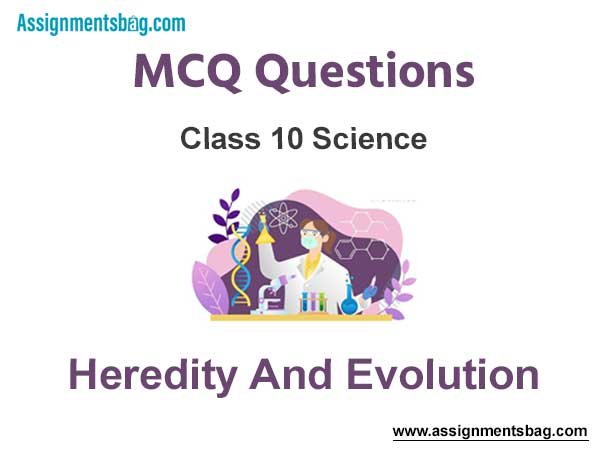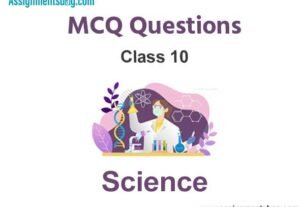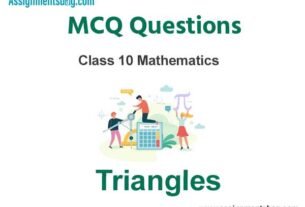Please refer to MCQ Questions Chapter 9 Heredity And Evolution Class 10 Science with answers provided below. These multiple-choice questions have been developed based on the latest NCERT book for class 10 Science issued for the current academic year. We have provided MCQ Questions for Class 10 Science for all chapters on our website. Students should learn the objective based questions for Chapter 9 Heredity And Evolution in Class 10 Science provided below to get more marks in exams.
Chapter 9 Heredity And Evolution MCQ Questions
Please refer to the following Chapter 9 Heredity And Evolution MCQ Questions Class 10 Science with solutions for all important topics in the chapter.
MCQ Questions Answers for Chapter 9 Heredity And Evolution Class 10 Science
Question: Which one of the following is not one of the direct conclusions that can be drawn from Mendel‘s experiment?
a) Only one parental trait is expressed
b) Two copies of each trait is inherited in sexually reproducing organism
c) For recessive trait to be expressed, both copies should be identical
d) Natural selection can alter frequency of an inherited trait
Answer
D
Question: Which of the following is controlled by genes? (i) Weight of a person (ii) Height of a person.
a) only 1 (i)
b) only (ii)
c) both (i) and (ii)
d) Sometimes (i) and sometimes (ii)
Answer
B
Question: Which one is a possible progeny in F2 generation of pure bred tall plant with round seed and short plant with wrinkled seeds?
a) Tall plant with round seeds
b) Tall plant with wrinkled seeds
c) Short plant with round seed
d) All of the above
Answer
D
Question: Which of the following is a totally impossible outcome of Mendel‘s Experiment (cross breeding pure breed tall and short pea plants)?
a) 3 tall 1 short plant
b) 24 tall and 8 short plants
c) 8 tall and 0 short plants
d) 4 tall plants and 1 medium-height plant
Answer
D
Question: Who have a perfect pair of sex chromosomes?
a) Girls only
b) Boys only
c) Both girls and boys
d) It depends on many other factors
Answer
A
Question: There is an inbuilt tendency of variation during reproduction because of– (i) Errors in DNA copying (ii)Sexual reproduction
a) only (i)
b) only (ii)
c) both (i) and (ii)
d) none of them
Answer
B
Question: Which one of the following gives a survival advantage and thus alters frequency of inherited trait. (i)Natural selection (ii) genetic drift
a) only (i)
b) only (ii)
c) both (i) and (ii)
d) none of these
Answer
A
Question: Formation of 2 independent species due to genetic drift, geographical isolation, natural selection is specifically referred as –
a) Evolution
b) Classification
c) Speciation
d) Reproduction
Answer
C
Question: If we breed a group of squirrels and surgically remove their tails, then amongst the progeny of these tailless squirrels –
a) All have no tail
b) All have a tail
c) Some of them have tails
d) Cannot be determined
Answer
B
Question: With whom we associate theory of evolution?
a) Charles Darwin
b) Mendel
c) Stanley Miller
d) Harold Urey
Answer
A
Question: Two pink coloured flowers on crossing resulted in 1 red, 2 pink and 1 white flowers progeny. The nature of the cross will be
a) Double fertilisation
b) Self pollination
c) cross fertilisation
d) no fertilisation
Answer
C
Question: The maleness of a child is determined by
a) the X chromosome in the zygote
b) the Y chromosome in zygote
c) the cytoplasm of germ cell which determines the sex
d) sex is determined by chance
Answer
B
Question: Amongst which of the following animals, sex of the offspring not genetically determined?
a) Humans
b) Snails
c) Birds
d) Dogs
Answer
B
Question: What is the probability that a human progeny will be a boy?
a) 50%
b) 56%
c) 47.34%
d) It varies
Answer
A
Question: Homologous organs have
a) Same structure, same function
b) Different structure, different function
c) Same structure, different function
d) Same function, different structure
Answer
C
Question: How can we know how old fossils are?
a) Fossils found closer to surface are recent than those found much below
b) Detecting ratios of isotopes
c) Studying its characteristics
d) All of these
Answer
D
Question: Analogous organs have
a) Same structure, same function
b) Different structure, different function
c) Same structure, different function
d) Same function, different structure
Answer
D
Question:Which one of the following strongly indicates that bird and dinosaurs are closely related?
a) They both have feathers
b) They both respire
c) They both reproduce
d) They both have eyes
Answer
A
Question: Fossils help
a) To study evolution
b) To understand climatic conditions in past
c) For a hierarchy of organisms (classification)
d) They help in all the above
Answer
D
Question: Wild cabbage is being cultivated for thousands of years and humans have generated broccoli,cauliflower, kala etc. from it. This is an example of
a) Natural selection
b) Genetic drift
c) Geographic isolation
d) Artificial selection
Answer
D
Question:Which of the following can be called a characteristic?
a) Plants can photosynthesis
b) We have 2 eyes
c) Mango tree is multicellular
d) All of these
Answer
D
Question: Which of the following statement is incorrect?
a) For every hormone there is a gene
b) For every protein there is a gene
c) For production of every enzyme there is a gene
d) For every molecule of fat there is a gene
Answer
D
Question: If A and B have n characteristics common while A and C have n/2 characteristics common, then which of the two organisms are more closely related?
a) A and C
b) A and B
c) Characteristics need to be known
d) None of these
Answer
C
Question: Organism A recently came into existence while B was formed millions of years ago. What does this indicate? (i) A is more efficient than B (ii) A is more complex than
a) Only (i)
b) Only (ii)
c) Both (i) and (ii)
d) Either (i) or (ii)
Answer
B
Question. Which is the example of homologous organs?
a) Forelimbs of man and wings of bird
b) Wings of birds and wings of insects
c) Vermiform appendix and nictitating membrane
d) Archaeopteryx and Balanoglossus
Answer
A
Question. A complete set of chromosomes inherited as a unit from one parent, is known as:
a) Karyotype
b) Gene pool
c) Genome
d) Genotype
Answer
C
Question. Which of the following features do humans lack that other primates have ?
a) Forward-facing eyes
b) Short snouts
c) Flexible shoulder and elbow joints
d) Opposable big toes
Answer
D
Question. Chemically a nucleotide has a:
a) Pentose group
b) Nitrogenous base
c) Phosphate group
d) All of these
Answer
D
Question. A pure tall plant can be differentiated from a hybrid tall plant:
a) By measuring length of plant
b) By spraying gibberellins
c) If all plants are tall after self-pollination
d) If all plants are dwarf after self-pollination
Answer
C
Question. In fruit flies wild-type colour is red and is dominant to white eye colour. Because this eye colour is located on the:
a) Y chromosome only.
b) autosome only.
c) X and Y chromosomes
d) X chromosome only.
Answer
A
Question. The earliest living organisms were:
a) Multicellular
b) Eukaryotes
c) Prokaryotes
d) None of these
Answer
C
Question. Mendel formulated some laws which are known as
a) Laws of germplasm
b) Laws of origin of species
c) Laws of recapitulation
d) Laws of inheritance
Answer
D
Question. An allele is said to be dominant if
a) it is expressed only in heterozygous combination.
b) it is expressed only in homozygous combination.
c) it is expressed in both homozygous and heterozygous condition.
d) it is expressed only in second generation.
Answer
C
Question. Mendel’s concept of segregation implies that the two members of an allelic pair of genes –
a) are distributed to separate gametes
b) may contaminate one another
c) are segregated in pairs
d) are linked
Answer
A
Question: A cross between a tall plant (TT) and short pea plant (tt) resulted in progeny that were all tall plants because
a) tallness is the dominant trait
b) shortness is the dominant trait
c) tallness is the recessive trait
d) height of pea plant is not governed by gene ‘T‘ or ‘t‘
Answer
A
Question: If a round, green seeded pea plant (RR yy) is crossed with wrinkled, yellow seeded pea plant, (rr YY) the seeds produced in F1 generation are
a) round and yellow
b) round and green
c) wrinkled and green
d) wrinkled and yellow
Answer
A
Question: New species may be formed if
i) DNA undergoes significant changes in germ cells
ii) chromosome number changes in the gamete
iii) there is no change in the genetic material
iv) mating does not take place
a) (i) and (ii)
b) (i) and (iii)
c) (ii), (iii) and (iv)
d) (i), (ii) and (iii)
Answer
A
Question: In human males all the chromosomes are paired perfectly except one. This/these unpaired chromosome is/are (i) large chromosome (ii) small chromosome (iii) Y-chromosome (iv) X-chromosome
a) (i) and (ii)
b) (iii) only
c) (iii) and (iv)
d) (ii) and (iv)
Answer
C
Question: Exchange of genetic material takes place in
a) vegetative reproduction
b) asexual reproduction
c) sexual reproduction
d) budding
Answer
C
Question: Select the incorrect statement
a) Frequency of certain genes in a population change over several generations resulting in evolution
b) Reduction in weight of the organism due to starvation is genetically controlled
c) Low weight parents can have heavy weight progeny
d) Traits which are not inherited over generations do not cause evolution
Answer
B
Question: Two pea plants one with round green seeds (RRyy) and another with wrinkled yellow (rrYY) seeds produce F1 progeny that have round, yellow (RrYy) seeds. When F1 plants are selfed, the F2 progeny will have new combination of characters. Choose the new combination from the following i) Round, yellow ii) Round, green iii) Wrinkled, yellow iv) Wrinkled, green
a) (i) and (ii)
b) (i) and (iv)
c) (ii) and (iii)
d) (i) and (iii)
Answer
B
Question: From the list given below, select the character which can be acquired but not inherited
a) colour of eye
b) colour of skin
c) size of body
d) nature of hair
Answer
C
Question: A basket of vegetables contains carrot, potato, radish and tomato. Which of them represent the correct homologous structures?
a) Carrot and potato
b) Carrot and tomato
c) Radish and carrot
d) Radish and potato
Answer
C
Question: A zygote which has an X-chromosome inherited from the father will develop into a
a) boy
b) girl
c) X- chromosome does not determine the sex of a child
d) either boy or girl
Answer
B
Question: Select the correct statement
a) Tendril of a pea plant and phylloclade of Opuntia are homologous
b) Tendril of a pea plant and phylloclade of Opuntia are analogous
c) Wings of birds and limbs of lizards are analogous
d) Wings of birds and wings of bat are homologous
Answer
D
Question: If the fossil of an organism is found in the deeper layers of earth, then we can predict that
a) the extinction of organism has occurred recently
b) the extinction of organism has occurred thousands of years ago
c) the fossil position in the layers of earth is not related to its time of extinction
d) time of extinction cannot be determined
Answer
B
Question: Select the group which shares maximum number of common characters
a) two individuals of a species
b) two species of a genus
c) two genera of a family
d) two genera of two families
Answer
A
Question: Which of the following statements is not true with respect to variation?
a) All variations in a species have equal chance of survival
b) Change in genetic composition results in variation
c) Selection of variants by environmental factors forms the basis of evolutionary processes
d) Variation is minimum in asexual reproduction
Answer
A
Question: In peas, a pure tall plant (TT) is crossed with a short plant (tt). The ratio of pure tall plants to short plants in F2 is
a) 1 : 3
b) 3 : 1
c) 1 : 1
d) 2 : 1
Answer
B
Question: A trait in an organism is influenced by
a) paternal DNA only
b) maternal DNA only
c) both maternal and paternal DNA
d) neither by paternal nor by maternal DNA
Answer
C
Question: According to the evolutionary theory, formation of a new species is generally due to
a) sudden creation by nature
b) accumulation of variations over several generations
c) clones formed during asexual reproduction
d) movement of individuals from one habitat to another
Answer
B
Question: The two versions of a trait (character) which are brought in by the male and female gametes are situated on
a) copies of the same chromosome
b) two different chromosomes
c) sex chromosomes
d) any chromosome
Answer
A
Question: The number of pair (s) of sex chromosomes in the zygote of humans is
a) one
b) two
c) three
d) four
Answer
A
Question: Select the statements that describe characteristics of genes
i) genes are specific sequence of bases in a DNA molecule
ii) a gene does not code for proteins
iii) individuals of a given species, a specific gene is located on a particular chromosome
iv) each chromosome has only one gene
a) (i) and (ii)
b) (i) and (iii)
c) (i) and (iv)
d) (ii) and (iv)
Answer
B
Question: The theory of evolution of species by natural selection was given by
a) Mendel
b) Darwin
c) Morgan
d) Lamarck
Answer
B
Question: In human males all the chromosomes are paired perfectly except one. This/these unpaired chromosome is/are
a) Large chromosome
b) small chromosome
c) Y – chromosome
d) X – chromosome
Answer
C
Question: Select the group which shares the maximum number of common characters:
a) Two individuals of a species
b) Two species of a genus
c) Two genera of a family
d) Two genera of two families
Answer
A
Question: A trait in an organism is influenced by:
a) Paternal ONA only
b) Maternal DNA only
c) Both maternal and paternal DNA
d) Neither paternal, nor maternal DNA
Answer
C
(a) If both Assertion and Reason are correct and Reason is the correct explanation of Assertion.
(b) If both Assertion and Reason are correct, but Reason is not the correct explanation of Assertion.
(c) If Assertion is correct but Reason is incorrect.
(d) If Assertion is incorrect but Reason is correct.
Question. Assertion: The genetic complement of an organism is called genotype.
Reason: Genotype is the type of hereditary properties of an organism.
Answer
A
Question. Assertion: The establishment of reproductive isolations in an event of biological significance.
Reason: In the absence of reproductive isolation species can merge back into single population.
Answer
A
Question. Assertion: DNA fingerprinting is a method in which polymerase chain reaction followed by DNA probe is used.
Reason: A DNA fingerprint is inherited and therefore, resembles that of parents.
Answer
A
Question. Assertion: Ear muscles of external ear in man are poorly developed.
Reason: These muscles are useful which move external ear freely to detect sound efficiently.
Answer
C
Question. Assertion: Chromosomes are known as hereditary vehicles.
Reason: The chromosomes are capable of selfreproduction and maintaining morphological and physiological properties through successive generations.
Answer
A
Fill in the Blanks :
Question. Wind of bat and wing of bird are the example of the ……………. organs.
Answer
analogous
Question. Mendel performed his experiments on ……………
Answer
garden pea
Question. Mendel choose ………………………….. characters in Pea for his experiments.
Answer
Seven
Question. Broccoli has been developed from ……………. cabbage through artificial selection.
Answer
Wild
Question. Theory of natural selection was proposed by ……………
Answer
Darwin
Question. ………………………….. speciation occurs in geographically separated populations.
Answer
Allopatric
Question. Mendelian factors or genes as well as chromosomes arepresent in …………….
Answer
pairs
True / False :
Question. Changes in the non-reproductive tissues caused by environmental factors are inheritable.
Answer
False
Question. Life can originate on earth from pre-existing life only.
Answer
True
Question. The atmosphere of the primitive earth was reducing.
Answer
True
Question. Exchange of genetic material takes place in asexual reproduction.
Answer
False
Question. Sex is determined by different factors in various species.
Answer
True

We hope you liked the above provided MCQ Questions Chapter 9 Heredity And Evolution Class 10 Science with solutions. If you have any questions please ask us in the comments box below.


